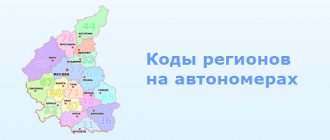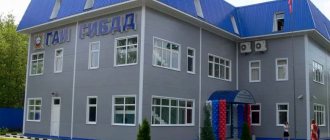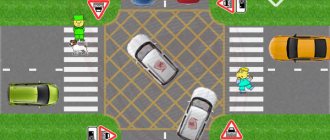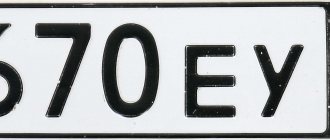Good afternoon, dear reader.
In this article we will talk about state registration plates (car license plates) . Number plates for a car are issued immediately after its registration with the traffic police and remain in place until one of the next owners decides to replace them.
Registration marks are unique, i.e. Two different cars cannot have the same number plates at the same time. The numbers always differ by at least one letter or number. Today we will look at the features and procedure for issuing license plates, as well as automobile region codes on the license plates.
The procedure for issuing license plates in Russia
Let's consider the most common type of numbers in the Russian Federation:
These are the numbers that are installed on most cars.
At first glance, the number consists of a random sequence of letters and numbers. In fact, not everything is so simple here.
All numbers from 0 to 9 are used on license plates. However, unlike numbers, not all letters of the Russian alphabet can appear on license plates. This privilege is given only to those letters that have similar spellings in the Latin alphabet. Those. Only the letters A, B, E, K, M, N, O, R, S, T, U, X can be used on license plates.
You might have learned about this fact before, but the next thought will probably seem interesting to you. We will talk about the order in which the numbers are issued .
Numbers are issued in order (except for special series). However, the order in which the characters change in the number is far from normal perception. The symbols do not change from right to left, but somewhat differently - in a rather confusing sequence.
1. Most often, the third digit in the license plate changes (in the figure it is number 6). After the number T356OK the number T357OK will be issued.
2. The second most frequently changing symbol is the 2nd digit (in Figure 5). After the number T359OK the number T360OK will be issued.
3. The third most common symbol is the 1st digit (in Figure 3). After the number T399OK the number T400OK will be issued.
The numbers seem to be okay, but the same cannot be said about the letters.
4. The fourth most common symbol is the 1st letter (T in the picture). After the number T999OK the number U001OK will be issued.
5. The fifth most common symbol is the 3rd letter (K in the figure). After the number X999OK the number A001OM will be issued.
6. The sixth most common symbol is the 2nd letter (O in the picture). After the number X999OX the number A001PA will be issued.
The procedure is quite complicated, so if you didn’t understand it the first time, re-read points 1-6 again.
The symbols on the left side of the registration plate, which were discussed above, are responsible for vehicle numbers within a specific region. By the way, I inform statistics lovers that in one region no more than 1 million 726 thousand 272 car registration plates can be issued.
After this limit is exhausted, the number of the Russian region written on the right side of the number changes. From this moment on, numbers begin to be issued again within the new region. Each subject of the Russian Federation has its own code, and some subjects of the federation, which have a very large number of cars, are assigned several region codes at the same time.
Region codes on license plates in 2021
Good afternoon, dear reader.
In this article we will talk about state registration plates (car license plates) . The numbers are assigned to the car during its registration with the traffic police and remain in place until one of the next owners decides to replace them, or the car’s registration is terminated.
Registration marks are unique, i.e. Two different cars cannot have the same number plates at the same time. The numbers always differ by at least one letter or number. Today we will look at the features and procedure for issuing license plates, as well as automobile region codes on the license plates.
2021 and 2021 Automotive Region Code Table
| Code | The subject of the Russian Federation |
| 01 | Republic of Adygea |
| 02, 102 | Republic of Bashkortostan |
| 03 | The Republic of Buryatia |
| 04 | Altai Republic (Altai Mountains) |
| 05 | The Republic of Dagestan |
| 06 | The Republic of Ingushetia |
| 07 | Kabardino-Balkarian Republic |
| 08 | Republic of Kalmykia |
| 09 | Republic of Karachay-Cherkessia |
| 10 | Republic of Karelia |
| 11 | Komi Republic |
| 12 | Mari El Republic |
| 13, 113 | The Republic of Mordovia |
| 14 | The Republic of Sakha (Yakutia) |
| 15 | Republic of North Ossetia-Alania |
| 16, 116, 716 | Republic of Tatarstan |
| 17 | Tyva Republic |
| 18 | Udmurt republic |
| 19 | The Republic of Khakassia |
| 21, 121 | Chuvash Republic |
| 22 | Altai region |
| 23, 93, 123 | Krasnodar region |
| 24, 84, 88, 124 | Krasnoyarsk region |
| 25, 125 | Primorsky Krai |
| 26, 126 | Stavropol region |
| 27 | Khabarovsk region |
| 28 | Amur region |
| 29 | Arhangelsk region |
| 30 | Astrakhan region |
| 31 | Belgorod region |
| 32 | Bryansk region |
| 33 | Vladimir region |
| 34, 134 | Volgograd region |
| 35 | Vologda Region |
| 36, 136 | Voronezh region |
| 37 | Ivanovo region |
| 38, 85, 138 | Irkutsk region |
| 39, 91 | Kaliningrad region |
| 40 | Kaluga region |
| 41 | Kamchatka Krai |
| 42, 142 | Kemerovo region |
| 43 | Kirov region |
| 44 | Kostroma region |
| 45 | Kurgan region |
| 46 | Kursk region |
| 47, 147 | Leningrad region |
| 48 | Lipetsk region |
| 49 | Magadan Region |
| 50, 90, 150, 190, 750 | Moscow region |
| 51 | Murmansk region |
| 52, 152 | Nizhny Novgorod Region |
| 53 | Novgorod region |
| 54, 154 | Novosibirsk region |
| 55 | Omsk region |
| 56, 156 | Orenburg region |
| 57 | Oryol Region |
| 58 | Penza region |
| 59, 81, 159 | Perm region |
| 60 | Pskov region |
| 61, 161, 761 | Rostov region |
| 62 | Ryazan Oblast |
| 63, 163, 763 | Samara Region |
| 64, 164 | Saratov region |
| 65 | Sakhalin region |
| 66, 96, 196 | Sverdlovsk region |
| 67 | Smolensk region |
| 68 | Tambov Region |
| 69 | Tver region |
| 70 | Tomsk region |
| 71 | Tula region |
| 72 | Tyumen region |
| 73, 173 | Ulyanovsk region |
| 74, 174 | Chelyabinsk region |
| 75, 80 | Transbaikal region |
| 76 | Yaroslavl region |
| 77, 97, 99, 177, 197, 199, 777, 799 | Moscow |
| 78, 98, 178, 198 | Saint Petersburg |
| 79 | Jewish Autonomous Region |
| 82 | Republic of Crimea |
| 83 | Nenets Autonomous Okrug |
| 86, 186 | Khanty-Mansiysk Autonomous Okrug - Ugra |
| 87 | Chukotka Autonomous Okrug |
| 89 | Yamalo-Nenets Autonomous Okrug |
| 92 | Sevastopol |
| 94 | Territories located outside the Russian Federation and served by the Department of Security Facilities of the Ministry of Internal Affairs of Russia |
| 95 | Chechen Republic |
What is region 716 on license plates?
Our country is quite wide. It is incredibly large, making it one of the largest in the world, if not the most enormous.
And in it there are many cities and various republics, which are designated for everyone in their own way. This is how designations were created even for cars, so that it is clear where the driver came from. How can we understand this?
The license plates of each car have their own codes . These codes belong to certain regions of Russia.
Today we will talk about a region called 716. What kind of region is this? What city is this? We'll sort it all out.
Who owns region 716
In fact, region 716 is a remake of region number 116 . That is, previously this region had the number 116, but over time it was changed. We made 716. And the question arises - what kind of region is this? The answer is simple - this is Kazan, Tatarstan.
The fact that this change would come into force was known back in 2014. Such license plates on a car allow you not only to understand what region the driver is from, but also for the traffic police officer to understand what to do next. Since if this is a resident of a different city, then the documents may be checked more carefully.
It immediately becomes clear that without such numbers it is very difficult to understand where the driver is from. Even through viewing the camera, it is impossible to determine the license plate number for further action. Changing your number not only gives you the opportunity to update your numbers, but also get newer ones.
So, every driver is now forced to change his license plate number from 116 to 716 so that in the future he will not have problems with the traffic police. Traffic police officers must also be constantly aware of which region a certain number belongs to.
At the moment, Tatarstan has three identifying numbers . The first is 16, the second is 116 and the third, of course, is 716. Imagine what would happen if there were no such numbers. All drivers would be no different, because the numbers of one driver essentially mean nothing to another. It is impossible to get through the license plate numbers of the car.
So imagine the situation that when you go to another city you meet a person with numbers similar to yours, but he does not have a region. You won't even be able to figure out what city he's from without talking to him in person. Imagine if the car was stolen. Then it will be extremely difficult for traffic police officers to catch her and identify her.
Therefore, remember that regions should always be indicated on your numbers. There is no other way. Without this, it will be extremely difficult and inconvenient to identify them. In addition, license plates from other regions must be carefully checked by traffic police officers.
However, you can rejoice those drivers who did not perform any actions with their car from the very beginning. They may not change the numbers since the car was not in a state of change. Numbers of such regions exist not only in Russia, of course. They exist everywhere.
It really makes things easier for everyone. Especially traffic police officers. For example, the same system works in Ukraine and there it is quite easy to figure out which number belongs to which region.
43 regions in Russia . Each of them has its own numbers. Different regions also have several numbers, as is the case with Tatarstan. This makes it easier for drivers to understand where their colleagues are from.
By the way, numbers from completely different regions can be found not only in Russia. A photograph appeared online of a driver with Russian license plates driving around Dubai. This is quite possible, since the road can be very unpredictable. Tatarstan is not a very large republic, so it has quite a lot of numbers that are exactly the numbers of this region.
That is, not many people come here from other places. In general, the road itself is a very dangerous place. Many people die every day in road accidents . Fortunately, in region 716, not many people are involved in road accidents.
All this is due to the fact that the traffic there is very measured and not many drivers break the rules. Very good people make themselves known.
The largest cities in the republic
- Kazan - 1,231 thousand people.
- Naberezhnye Chelny - 529 thousand people.
- Nizhnekamsk - 236 thousand people.
- Almetyevsk - 152 thousand people.
- Zelenodolsk - 98 thousand people.
Total area of the region: 67,847 square kilometers.
Traffic jams in Kazan, according to Yandex, range from 1 to 3 points.
Motorization in region 16 (116 and 716): there are 0.261 cars per person according to 2013 data. This means: one car for about four people.
The population density of region 16 (116 and 716) is 57.26 people/km². (based on 2021 census data).
Tatarstan began issuing license plates for cars with the “716” series in 2021.
Code table
Regions in the table are sorted by number and divided for convenience into blocks of ten records. In parentheses after the name of the region are the years in which license plates with the corresponding region code were issued. For such regions, new codes have been introduced, which are listed at the end of the list, indicating the year of entry into force. Regions without indications in brackets use only one code, which is still valid today. To quickly obtain all the codes for a particular region, we recommend using the search form or referring to the list of regions with several codes located below the table.
- 01—09
- 01 - Republic of Adygea
- 02 - Republic of Bashkortostan (1993–2006)
- 03 - Republic of Buryatia
- 04 - Altai Republic
- 05 - Republic of Dagestan
- 06 – Republic of Ingushetia
- 07 – Kabardino-Balkarian Republic
- 08 – Republic of Kalmykia
- 09 – Karachay-Cherkess Republic
- 10—19
- 10 - Republic of Karelia
- 11 - Komi Republic
- 12 - Republic of Mari El
- 13 – Republic of Mordovia
- 14 - Republic of Sakha (Yakutia)
- 15 - Republic of North Ossetia-Alania
- 16 - Republic of Tatarstan (1993–2006)
- 17 - Republic of Tyva
- 18 - Udmurt Republic
- 19 – Republic of Khakassia
- 20—29
- 20 - Chechen Republic (1993–2000)
- 21 – Chuvash Republic
- 22 - Altai Territory
- 23 - Krasnodar region (1993–2005)
- 24 - Krasnoyarsk Territory (1993–2009)
- 25 - Primorsky Krai (1993–2005)
- 26 - Stavropol Territory
- 27 — Khabarovsk region
- 28 - Amur region
- 29 — Arkhangelsk region
- 30—39
- 30 — Astrakhan region
- 31 - Belgorod region
- 32 - Bryansk region
- 33 - Vladimir region
- 34 - Volgograd region (1993–2012)
- 35 – Vologda region
- 36 - Voronezh region
- 37 - Ivanovo region
- 38 — Irkutsk region
- 39 — Kaliningrad region
- 40—49
- 40 - Kaluga region
- 41 - Kamchatka region
- 42 - Kemerovo region (1993–2011)
- 43 - Kirov region
- 44 - Kostroma region
- 45 – Kurgan region
- 46 - Kursk region
- 47 - Leningrad region
- 48 — Lipetsk region
- 49 – Magadan region
- 50—59
- 50 - Moscow region (1993–2001)
- 51 - Murmansk region
- 52 - Nizhny Novgorod region (1993–2009)
- 53 - Novgorod region
- 54 - Novosibirsk region (1993–2010)
- 55 — Omsk region
- 56 - Orenburg region
- 57 - Oryol region
- 58 - Penza region
- 59 - Perm region (1993–2010)
- 60—69
- 60 - Pskov region
- 61 - Rostov region (1993–2007)
- 62 - Ryazan region
- 63 - Samara region (1993–2007)
- 64 - Saratov region
- 65 - Sakhalin region
- 66 - Sverdlovsk region (1993–2006)
- 67 - Smolensk region
- 68 - Tambov region
- 69 - Tver region
- 70—79
- 70 - Tomsk region
- 71 - Tula region
- 72 - Tyumen region
- 73 - Ulyanovsk region
- 74 - Chelyabinsk region (1993–2007)
- 75 – Transbaikal region
- 76 - Yaroslavl region
- 77 – Moscow
- 78 - St. Petersburg (1993–2004)
- 79 – Jewish Autonomous Region
- 80—89
- 80 - Transbaikal region
- 81 - Perm region
- 82 - Republic of Crimea (since 2014)
- 83 – Nenets Autonomous Okrug
- 84 - Krasnoyarsk region
- 85 — Irkutsk region
- 86 - Khanty-Mansiysk Autonomous Okrug (1993–2012)
- 87 – Chukotka Autonomous Okrug
- 88 - Krasnoyarsk region
- 89 – Yamalo-Nenets Autonomous Okrug
- 90—99
- 90 - Moscow region (2001–2006)
- 91 - Kaliningrad region
- 92 - Sevastopol (since 2014)
- 93 - Krasnodar region (2005–2011)
- 94 - Territories located outside the Russian Federation and served by the Department of Security Facilities of the Ministry of Internal Affairs of Russia
- 95 - Chechen Republic (since 2000)
- 96 - Sverdlovsk region (2006–2013)
- 97 - Moscow (2002–2005)
- 98 - St. Petersburg (2004–2010)
- 99 - Moscow (1998–2002)
- 100—199
- 102 - Republic of Bashkortostan (since 2006)
- 113 – Republic of Mordovia
- 116 - Republic of Tatarstan (since 2006)
- 121 – Chuvash Republic
- 123 - Krasnodar region (since 2011)
- 124 - Krasnoyarsk Territory (since 2009)
- 125 - Primorsky Territory (since 2005)
- 126 - Stavropol Territory
- 134 - Volgograd region (since 2012)
- 136 - Voronezh region
- 138 — Irkutsk region
- 142 - Kemerovo region (since 2011)
- 150 - Moscow region (2006–2009)
- 152 - Nizhny Novgorod region (since 2009)
- 154 - Novosibirsk region (since 2010)
- 159 - Perm region (since 2010)
- 161 - Rostov region (since 2007)
- 163 - Samara region (since 2007)
- 164 - Saratov region
- 173 - Ulyanovsk region
- 174 - Chelyabinsk region (since 2007)
- 177 – Moscow
- 178 - St. Petersburg (since 2010)
- 186 - Khanty-Mansiysk Autonomous Okrug (since 2012)
- 190 - Moscow region (2009–2013)
- 196 - Sverdlovsk region (since 2013)
- 197 - Moscow (2010–2013)
- 199 - Moscow (2007–2010)
- 200—299
- 277 — Moscow
- 299 — Moscow
- 700—799
- 716 - Republic of Tatarstan (from 2021)
- 725 — Primorsky Krai
- 750 - Moscow region (since 2013)
- 763 - Samara region
- 777 - Moscow (2013–2017)
- 790 — Moscow region
- 799 - Moscow (from 2021)
Old and new codes
For 2021, 29 old codes are allocated, license plate numbers for which are not issued. Their list: 02, 16, 20, 23, 24, 25, 34, 42, 50, 52, 54, 59, 61, 63, 66, 74, 78, 86, 90, 93, 96, 97, 98, 99 , 150, 190, 197, 199, 777. 22 new codes are used instead of the old ones. List of new codes indicating the year of entry into force:
- 2000 - 95 (Chechen Republic)
- 2005 - 125 (Primorsky Territory)
- 2006 - 102 (Republic of Bashkortostan), 116 (Republic of Tatarstan)
- 2007 - 174 (Chelyabinsk region), 161 (Rostov region), 163 (Samara region)
- 2009 - 124 (Krasnoyarsk Territory), 152 (Nizhny Novgorod Region)
- 2010 - 178 (St. Petersburg), 154 (Novosibirsk region), 159 (Perm region)
- 2011 - 123 (Krasnodar region), 142 (Kemerovo region)
- 2012 - 134 (Volgograd region), 186 (Khanty-Mansi Autonomous Okrug)
- 2013 - 750 (Moscow region), 196 (Sverdlovsk region)
- 2014 - 92 (Sevastopol), 82 (Republic of Crimea)
- 2017 - 799 (Moscow), 716 (Republic of Tatarstan).
List of subjects of the Russian Federation with two or more codes:
- Volgograd region - 34, 134
- Kemerovo region - 42, 142
- Krasnodar region - 23, 93, 123
- Krasnoyarsk Territory - 24, 124
- Moscow - 97, 99, 197, 199, 777, 799
- Moscow region - 50, 90, 150, 190, 750
- Nizhny Novgorod region - 52, 152
- Novosibirsk region - 54, 154
- Perm region - 59, 159
- Primorsky Territory - 25, 125
- Republic of Bashkortostan - 02, 102
- Republic of Tatarstan - 16, 116, 716
- Rostov region - 61, 161
- Samara region - 63, 163
- St. Petersburg - 78, 98, 178
- Sverdlovsk region - 66, 96, 196
- Khanty-Mansiysk Autonomous Okrug - 86, 186
- Chelyabinsk region - 74, 174
- Chechen Republic - 20, 95
As of 2021, there are 19 such entities. Moscow and the Moscow region have the most codes, which is explained by the large number of cars owned by residents of the region.
Explanations and comments
According to the Order of the Ministry of Internal Affairs of January 5, 2000 No. 5, in 2000 all license plates of the Chechen Republic were replaced: instead of code 20, code 95 was used. License plates with code 20 can no longer be found on the roads. This measure is related to counteracting the situation of accumulation of criminal vehicles at that time.
According to the Order of the Ministry of Internal Affairs of June 26, 2013 No. 478, three-digit codes with the first digit 7 (777, 779, 799, etc.) were introduced in 2013. Instead of the expected 2, the number 7 is used, since a) 2 does not fit into the space allocated for the region code on the registration plate, b) 7 is better recognized by cameras recording offenses. However, a limited series of numbers with codes 277 and 299 were still issued.
The Perm region has three codes: 59, 81, 159. Code 81 is out of logic. This is due to the fact that on December 1, 2005, the Komi-Permyak Autonomous Okrug (code 81) and the Perm region (code 59) were united into the Perm Territory. Accordingly, code 81 passed to the Perm region.
According to the Order of the Ministry of Internal Affairs of August 7, 2013 No. 605, when reselling a car, it is allowed to keep the old license plates. Replacement with new numbers can be carried out at the request of the new owner. Thus, linking the code on the license plate to the region of residence/registration of the owner ceases to be relevant.
Types of registration plates
Registration plates are needed in order to identify the driver who violated the traffic rules and collect a fine from him. Car signs come in different types - they not only differ in code, but can also have different shapes and background colors.
Main types of signs in the Russian Federation:
- Registration plate for a passenger car. It is drawn up in accordance with the GOST standard and contains three letters and three numbers, followed by the region code. This sign must be affixed to both the front and rear of the vehicle.
- License plate for trailer. The format of this sign is slightly different - four numbers followed by two letters. Recently, the rule that you need to duplicate the number on the front and back has been abolished.
- Sign for tractors and trailers for them. Used for self-propelled and agricultural machinery. It should be noted that the format of the number is practically no different from the sign for a motorcycle. A reflective layer is also applied, with 4 numbers on the top line and two letters on the bottom line. The region number is indicated at the bottom, in the right corner.
- Another type of license plates is transit. Transit signs are used for those vehicles that have been deregistered but not re-registered at the traffic police department. In the modern format, this number has two letters, three numbers, and after them one more letter. This sign can be printed on very thick paper with a glow effect, but it must be laminated. This sign replaced the old transit numbers, which were located at the top of the glass and printed on plain paper, for the reason that they were difficult to see.
- Sign for vehicles traveling abroad. Used for vehicles transported out of the country. The common format is two letters and three numbers, and the difference from a regular number is the presence of the letter “T” at the very beginning of the code.
- Sign of a vehicle belonging to the Ministry of Internal Affairs of the Russian Federation. On it, letters and numbers are printed in white on a blue background. The index belonging to the MFD is indicated - 77.
- A sign used on vehicles belonging to employees and diplomatic organizations. For this type of sign, several letter codes are used:
- CD – the car belongs to the person heading the diplomatic consulate department. This could be a diplomat or an ambassador.
- CC – the vehicle was registered to the person in charge of the consular department.
- D – the car is under the jurisdiction of the diplomatic mission.
- T – the vehicle is registered by a person who is an administrative and technical employee of a consulate or an international organization.
- License plate of vehicles belonging to a military unit. The code contains four numbers and two letters, and is printed on a black background in white letters. Please note that the numbers indicated on the right side of the sign do not indicate any region. They indicate that the vehicle belongs to a specific military district, branch of the RF Armed Forces.









